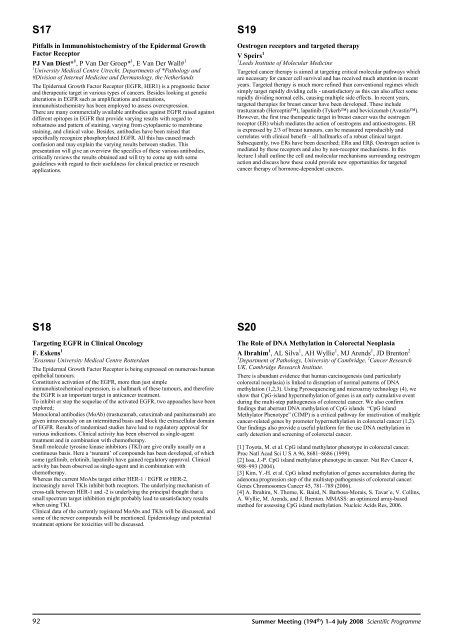2008 Summer Meeting - Leeds - The Pathological Society of Great ...
2008 Summer Meeting - Leeds - The Pathological Society of Great ...
2008 Summer Meeting - Leeds - The Pathological Society of Great ...
You also want an ePaper? Increase the reach of your titles
YUMPU automatically turns print PDFs into web optimized ePapers that Google loves.
S17Pitfalls in Immunohistochemistry <strong>of</strong> the Epidermal GrowthFactor ReceptorPJ Van Diest* 1 , P Van Der Groep* 1 , E Van Der Wall# 11 University Medical Centre Utrecht, Departments <strong>of</strong> *Pathology and#Division <strong>of</strong> Internal Medicine and Dermatology, the Netherlands<strong>The</strong> Epidermal Growth Factor Receptor (EGFR, HER1) is a prognostic factorand therapeutic target in various types <strong>of</strong> cancers. Besides looking at geneticalterations in EGFR such as amplifications and mutations,immunohistochemistry has been employed to assess overexpression.<strong>The</strong>re are many commercially available antibodies against EGFR raised againstdifferent epitopes in EGFR that provide varying results with regard torobustness and pattern <strong>of</strong> staining, varying from cytoplasmic to membranestaining, and clinical value. Besides, antibodies have been raised thatspecifically recognize phosphorylated EGFR. All this has caused muchconfusion and may explain the varying results between studies. Thispresentation will give an overview the specifics <strong>of</strong> these various antibodies,critically reviews the results obtained and will try to come up with someguidelines with regard to their usefulness for clinical practice or researchapplications.S19Oestrogen receptors and targeted therapyV Speirs 11 <strong>Leeds</strong> Institute <strong>of</strong> Molecular MedicineTargeted cancer therapy is aimed at targeting critical molecular pathways whichare necessary for cancer cell survival and has received much attention in recentyears. Targeted therapy is much more refined than conventional regimes whichsimply target rapidly dividing cells - unsatisfactory as this can also affect somerapidly dividing normal cells, causing multiple side effects. In recent years,targeted therapies for breast cancer have been developed. <strong>The</strong>se includetrastuzamab (Herceptin), lapatinib (Tykerb) and bevicizumab (Avastin).However, the first true therapeutic target in breast cancer was the oestrogenreceptor (ER) which mediates the action <strong>of</strong> oestrogens and antioestrogens. ERis expressed by 2/3 <strong>of</strong> breast tumours, can be measured reproducibly andcorrelates with clinical benefit – all hallmarks <strong>of</strong> a robust clinical target.Subsequently, two ERs have been described; ER and ER. Oestrogen action ismediated by these receptors and also by non-receptor mechanisms. In thislecture I shall outline the cell and molecular mechanisms surrounding oestrogenaction and discuss how these could provide new opportunities for targetedcancer therapy <strong>of</strong> hormone-dependent cancers.S18Targeting EGFR in Clinical OncologyF. Eskens 11 Erasmus University Medical Centre Rotterdam<strong>The</strong> Epidermal Growth Factor Receptor is being expressed on numerous humanepithelial tumours.Constitutive activation <strong>of</strong> the EGFR, more than just simpleimmunohistochemical expression, is a hallmark <strong>of</strong> these tumours, and thereforethe EGFR is an important target in anticancer treatment.To inhibit or stop the sequelae <strong>of</strong> the activated EGFR, two appoaches have beenexplored;Monoclonal antibodies (MoAb) (trastuzumab, cetuximab and panitumumab) aregiven intravenously on an intermittend basis and block the extracellular domain<strong>of</strong> EGFR. Results <strong>of</strong> randomised studies have lead to regulatory approval forvarious indications. Clinical activity has been observed as single-agenttreatment and in combination with chemotherapy.Small molecule tyrosine kinase inhibitors (TKI) are give orally usually on acontinuous basis. Here a ‘tsunami’ <strong>of</strong> compounds has been developed, <strong>of</strong> whichsome (gefitinib, erlotinib, lapatinib) have gained regulatory approval. Clinicalactivity has been observed as single-agent and in combination withchemotherapy.Whereas the current MoAbs target either HER-1 / EGFR or HER-2,increasingly novel TKIs inhibit both receptors. <strong>The</strong> underlying mechanism <strong>of</strong>cross-talk between HER-1 and -2 is underlying the principal thought that asmall spectrum target inhibition might probably lead to unsatisfactory resultswhen using TKI.Clinical data <strong>of</strong> the currently registered MoAbs and TKIs will be discussed, andsome <strong>of</strong> the newer compounds will be mentioned. Epidemiology and potentialtreatment options for toxicities will be discussed.S20<strong>The</strong> Role <strong>of</strong> DNA Methylation in Colorectal NeoplasiaAIbrahim 1 , AL Silva 1 , AH Wyllie 1 , MJ Arends 1 ,JD Brenton 21 Department <strong>of</strong> Pathology, University <strong>of</strong> Cambridge, 2 Cancer ResearchUK, Cambridge Research Institute.<strong>The</strong>re is abundant evidence that human carcinogenesis (and particularlycolorectal neoplasia) is linked to disruption <strong>of</strong> normal patterns <strong>of</strong> DNAmethylation (1,2,3). Using Pyrosequencing and microarray technology (4), weshow that CpG-island hypermethylation <strong>of</strong> genes is an early cumulative eventduring the multi-step pathogenesis <strong>of</strong> colorectal cancer. We also confirmfindings that aberrant DNA methylation <strong>of</strong> CpG islands “CpG IslandMethylator Phenotype” (CIMP) is a critical pathway for inactivation <strong>of</strong> multiplecancer-related genes by promoter hypermethylation in colorectal cancer (1,2).Our findings also provide a useful platform for the use DNA methylation inearly detection and screening <strong>of</strong> colorectal cancer.[1] Toyota, M. et al. CpG island methylator phenotype in colorectal cancer.Proc Natl Acad Sci U S A 96, 8681–8686 (1999).[2] Issa, J.-P. CpG island methylator phenotype in cancer. Nat Rev Cancer 4,988–993 (2004).[3] Kim, Y.-H. et al. CpG island methylation <strong>of</strong> genes accumulates during theadenoma progression step <strong>of</strong> the multistep pathogenesis <strong>of</strong> colorectal cancer.Genes Chromosomes Cancer 45, 781–789 (2006).[4] A. Ibrahim, N. Thorne, K. Baird, N. Barbosa-Morais, S. Tavar`e, V. Collins,A. Wyllie, M. Arends, and J. Brenton. MMASS: an optimized array-basedmethod for assessing CpG island methylation. Nucleic Acids Res, 2006.92 <strong>Summer</strong> <strong>Meeting</strong> (194 th ) 1–4 July <strong>2008</strong> Scientific Programme













